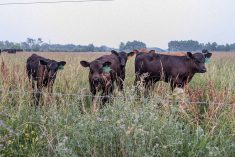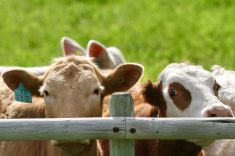VERNON, B.C. – A steady increase in the national cow herd means one thing – more beef.
As a stable, aging population, Canadians can’t eat all of the two billion pounds of beef that’s produced annually, so cattle producers must hone their sales skills to move their product to dinner plates around the world.
This message of new markets, accelerating production and opportunity was delivered at the British Columbia Cattlemen’s Association annual meeting in Vernon.
“We can’t eat it in North America. We’re going to have to find those markets or there will be a lot of cows and damned poor cowboys,” said Neil Jahnke, president of the Canadian Beef Export Federation.
Read Also

U.S. farm group supports supply management
U.S. grassroots farm advocacy group pushing new agriculture legislation that would move towards supply management like Canada has for dairy industry
The United States takes about 98 percent of Canadian beef. The federation wants to develop more markets in case the American market shrinks because of trade disputes or saturated markets.
One of the most promising markets is in the Asian nations where the federation is opening sales offices in South Korea this summer, and another to follow in Hong Kong. The federation has had an office in Tokyo for five years.
While Hong Kong doesn’t buy a lot of beef, it is the gateway to the People’s Republic of China. Canada was the first country to sell food to China and it is receptive to buying Canadian beef in the future, said Jahnke.
China has enough grazing range for cattle production but Chinese officials told him it could be a century before they would be self sufficient in beef.
Sales to other countries have also been promising.
Canada exported 8,400 tonnes of beef to Japan in 1994. This year the goal is 17,000 tonnes. Other market breakthroughs include South Korea where it’s expected to buy 20,000 tonnes of beef by the year 2000.
Serve niche markets
Jahnke sees great potential for Canada’s smaller packing plants which can serve niche markets.
The need to export is clear as the upsurge in Canadian production continues to reach record levels. There’s been a 33 percent increase in the Canadian herd since 1987. Actual meat production is expected to reach 2.8 billion pounds (1.3 billion kilograms), which will likely make 1995 a record year. Since 1987 to 1993 the average beef carcass has gained 90 pounds (41 kg), said Anne Dunford, senior market analyst for Canfax.
Cow numbers will probably peak in 1997 and considering the production cycle of cattle, peak beef production will follow two years later.
Beef, poultry and pork figures continue to have record levels of production.















